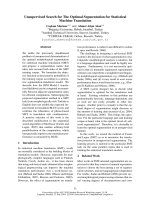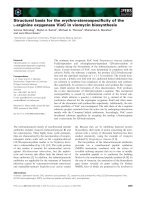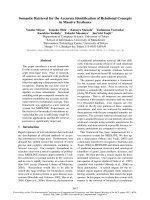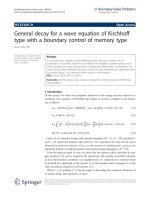Báo cáo toán học: " Vizing-like conjecture for the upper domination of Cartesian products of graphs – the proof" pot
Bạn đang xem bản rút gọn của tài liệu. Xem và tải ngay bản đầy đủ của tài liệu tại đây (85.25 KB, 6 trang )
Vizing-like conjecture for the upper domination
of Cartesian products of graphs – the proof
Boˇstjan Breˇsar
∗
University of Maribor, FEECS
Smetanova 17, 2000 Maribor, Slovenia
Submitted: Jul 7, 2004; Accepted: Jun 30, 2005; Published: Jul 19, 2005
Mathematics Subject Classifications: 05C69, 05C99
Abstract
In this note we prove the following conjecture of Nowakowski and Rall: For
arbitrary graphs G and H the upper domination number of the Cartesian prod-
uct G H is at least the product of their upper domination numbers, in symbols:
Γ(G H) ≥ Γ(G)Γ(H ).
A conjecture posed by Vizing [7] in 1968 claims that
Vizing’s conjecture: For any graphs G and H, γ(G H) ≥ γ(G)γ(H),
where γ, as usual, denotes the domination number of a graph, and G H is the Cartesian
product of graphs G and H. It became one of the main problems of graph domination,
cf. surveys [2] and [4, Section 8.6], and two recent papers [1, 6].
The unability of proving or disproving it lead authors to pose different variations of
the original problem. Several such variations were studied by Nowakowski and Rall in the
paper [5] from 1996. In particular, they proposed the following
Conjecture (Nowakowski, Rall): For any graphs G and H, Γ(G H) ≥ Γ(G)Γ(H),
where Γ denotes the upper domination of a graph. In this note we prove this conjecture.
In fact, if both graphs G and H are nontrivial (i.e. have at least two vertices) we prove
the following slightly stronger bound:
Γ(G H) ≥ Γ(G)Γ(H)+1.
∗
Supported by the Ministry of Education, Science and Sport of Slovenia under the grant Z1-3073-
0101-01.
the electronic journal of combinatorics 12 (2005), #N12 1
We start with basic definitions. For graphs G and H,theCartesian product G H
is the graph with vertex set V (G) × V (H) where two vertices (u
1
,v
1
)and(u
2
,v
2
)are
adjacent if and only if either u
1
= u
2
and v
1
v
2
∈ E(H)orv
1
= v
2
and u
1
u
2
∈ E(G). For
a set of vertices S ⊆ V (G) × V (H)letp
G
(S),p
H
(S) denote the natural projections of S
to V (G)andV (H), respectively.
AsetS ⊂ V (G) of vertices in a graph G is called dominating if for every vertex v ∈
V (G) \ S there exists a vertex u ∈ S that is adjacent to v. A dominating set S is minimal
dominating set if no proper subset of S is dominating. Minimal dominating sets give rise to
our central definition. The upper domination number Γ(G)ofagraphG is the maximum
cardinality of a minimal dominating set in G. Recall that the domination number γ(G)is
the minimum cardinality of a (minimal) dominating set in G. The following fundamental
result due to Ore, cf. [3, Theorem 1.1], characterizes minimal dominating sets in graphs.
Theorem 1 A dominating set S is a minimal dominating set if and only if for every
vertex u ∈ S one of the following two conditions holds:
(i) u is not adjacent to any vertex of S,
(ii) there exists a vertex v ∈ V (G) \ S such that u is the only neighbor of v from S.
Based on Ore’s theorem we present a partition of the vertex set of a graph depending
on a given minimal dominating set. Let D
G
be a minimal dominating set of a graph G.
If for a vertex u ∈ D
G
the condition (ii) of Theorem 1 holds, then we say that v is a
private neighbor of u (that is, v is adjacent only to u among vertices of D
G
). Note that
u can have more than one private neighbor. Also note that for a vertex u of D
G
both
conditions of Theorem 1 can hold at the same time, that is, it can have a private neighbor
and be nonadjacent to all other vertices of D
G
.DenotebyD
G
the set vertices of D
G
that
have a private neighbor, and by P
G
the set of vertices of V (G) \ D
G
which are private
neighbors of some vertex of D
G
.ByN
G
we denote the set of vertices of V (G) \ D
G
which
are adjacent to a vertex of D
G
but are not private neighbors of any vertex of D
G
.Set
D
G
= D
G
\ D
G
denoting the vertices of D
G
which do not have private neighbors (so they
must enjoy condition (i) of the theorem), and finally let the remaining set be R
G
,thatis
R
G
= V (G) \ (D
G
∪ P
G
∪ N
G
). We will skip the indices if the graph G will be understood
from the context. Note that given a minimal dominating set D of a graph G,thesets
D
,D
,P,N and R form a partition of the vertex set V (G). In addition, some pairs of
sets must clearly have adjacent vertices (like D
and P ), while some other pairs of sets
clearly do not have any adjacent vertices (like D
and D
). The situation is presented
in Figure 1, where doubled line indicates that between two sets there must be edges, a
normal line indicates that between the two sets edges are possible (but are not necessary),
and no line between two sets means no edges are possible. Note that every vertex of R is
adjacent to a vertex of D
, and that every vertex of N ∪ P is adjacent to a vertex of D
.
Of course, some of the sets could also be empty for some dominating sets.
If A and B are two subsets of the vertex set of a graph we say that A dominates
(vertices of) B if every vertex of B has a neighbor in A or is a vertex of A.Wemaythen
also say that B is dominated by (vertices of) A.
the electronic journal of combinatorics 12 (2005), #N12 2
D
N
D
RP
Figure 1: Partition of the vertex set
In the proof of the conjecture we will use two special sets, obtained by an operation of
completion of a certain set to a set that dominates a specified set of vertices of a graph.
Let us present these operations.
1. Let G be a graph, D a minimal dominating set, and D
,D
,P,N,Rthe correspond-
ing sets that form a partition of V (G). Let I be a subset of R.BySP(D
,I)wedenote
a subset of vertices from D
such that SP(D
,I) ∪ I dominates P ∪ N (itneednotbea
dominating set of entire graph), and is minimal in the folowing sense. For each vertex u
of SP(D
,I)
(*) there exists a vertex v ∈ P ∪N such that u is its only neighbor from SP(D
,I) ∪I.
That such a set always exists follows from two facts. First D
itself dominates P ∪ N
(and if I does not dominate any vertex of P ∪ N,thenD
is already minimal in the
above sense). Now, minimality condition can be easily achieved by adding to SP(D
,I)
vertex by vertex from D
that are needed to dominate vertices of P (those which are
not dominated by I), and after that, if some of the vertices of N remain undominated,
additional vertices from D
are added to SP(D
,I).
2. The second operation is a modification of the first, where we start with a subset
of D
∪ R instead of just R.SoletJ be a subset of D
∪ R.BySP
(D
,J)wedenotea
minimal set of vertices from D
such that N ∪P is dominated by vertices of J ∪SP
(D
,J).
Theorem 2 For any nontrivial graphs G and H,
Γ(G H) ≥ Γ(G)Γ(H)+1.
Proof. For the proof we will construct a minimal dominating set D of G H having
enough vertices. Let D
G
and D
H
be minimal dominating sets of G and H, respectively,
with maximum cardinality, that is |D
G
| =Γ(G)and|D
H
| =Γ(H).
Consider first the case where in one of the factors (say G)thesetD
is empty. Then
D := D
G
× V (H) is clearly a minimal dominating set (every vertex of D has a private
neighbor) with more than Γ(G)Γ(H) + 1 vertices. If both D
G
and D
H
are empty, then let
D := (D
G
× D
H
) ∪ I where I is a maximum independent set of the subgraph induced by
(V (G) \ D
G
) × (V (H) \ D
H
). Since I is obviously nonempty, D is a minimal dominating
set (it is a maximal independent set) with at least Γ(G)Γ(H) + 1 vertices.
In the sequel we may assume without loss of generality that D
H
= ∅,D
H
= ∅ and
D
G
= ∅. We will construct D as a union of six pairwise disjoint sets (in the case D
G
= ∅
the last three sets will be empty).
the electronic journal of combinatorics 12 (2005), #N12 3
Let the first set be D
1
= D
G
× D
H
(note that it has |D
G
|·Γ(H) vertices). Let the
second set (D
2
) be a maximum independent set I of the subgraph induced by R
G
× R
H
.
For each x ∈ R
G
denote by I
x
the set I ∩ ({x}×V (H)). Let SP(D
H
,p
H
(I
x
)) be the
subset of D
H
obtained by the operation defined above, and consider the corresponding
subset of GH,thatis{x}×SP(D
H
,p
H
(I
x
)). Let the third set of D be the union of all
such sets, that is
D
3
=
x∈R
G
{x}×SP(D
H
,p
H
(I
x
))
which is obviously a subset of R
G
× D
H
.
The fourth set is obtained similarly by reversing the roles of G and H. That is for
each y ∈ R
H
denote by I
y
the set I ∩ (V (G) ×{y}). Then SP(D
G
,p
G
(I
y
)) is a subset of
D
G
,andlet
D
4
=
y ∈R
H
SP(D
,p
G
(I
y
)) ×{y}
which is a subset of D
G
× R
H
.
For each y ∈ D
H
let J
y
be the set of vertices from V (G)×{y} that are already included
in D.Thatis
J
y
=(D
1
∪ D
3
) ∩ (V (G) ×{y}),
and for each such set add to D vertices in V (G) ×{y} by using the second operation from
above:
D
5
=
y ∈D
H
SP
(D
G
,p
G
(J
y
)) ×{y}
which is clearly a subset of D
G
× D
H
.
Finally, set
D
6
= D
G
× (V (H) \ (D
H
∪ R
H
)).
Since |P
H
|≥|D
H
|,weinfer|V (H) \ (D
H
∪ R
H
)|≥|D
H
|,andso|D
6
|≥|D
G
|·Γ(H).
Now, as said before let D = D
1
∪ D
2
∪ D
3
∪ D
4
∪ D
5
∪ D
6
and obviously the six sets
are pairwise disjoint. From previous observations we get
|D
1
| + |D
6
|≥|D
G
|·Γ(H)+|D
G
|·Γ(H)=|D
G
|·Γ(H)=Γ(G)Γ(H).
Since D
G
= ∅ and D
H
= ∅,wegetR
G
∪ N
G
= ∅ and R
H
∪ N
H
= ∅.IfR
G
= ∅ then D
5
must be nonempty. If R
G
= ∅ and R
H
= ∅ then D
3
must be nonempty. Finally, R
G
= ∅
and R
H
= ∅ implies D
2
is nonempty. We infer that |D|≥Γ(G)Γ(H)+1. (Thisiseven
easier to deduce if D
G
= ∅.)
In the rest of the proof we (must) show that D is a minimal dominating set of G H.
To prove that D is a dominating set we will partition GH and check for each part that
is dominated by D.
Vertices of D
G
× V (H) are obviously dominated by D
1
.
Next consider vertices of R
G
× V (H). Vertices of R
G
× R
H
are dominated by I = D
2
,
since it is its maximum (and thus maximal) independent set. Vertices of R
G
× D
H
are
the electronic journal of combinatorics 12 (2005), #N12 4
dominated by D
1
, and other vertices of R
G
× V (H) are dominated by D
2
∪ D
3
(by using
the operation SP).
Vertices of D
G
× V (H) are dominated by D
6
. Indeed, recall that D
6
is D
G
× (P
H
∪
D
H
∪ N
H
), and that P
H
∪ D
H
∪ N
H
is a dominating set of H.
Vertices of P
G
× V (H)andofN
G
× V (H) are dominated as follows. If y ∈ V (H)isa
vertex of R
H
then (P
G
∪ N
G
) ×{y} is dominated by D
2
∪ D
4
by using operation SP.If
y is in D
H
then (P
G
∪ N
G
) ×{y} is dominated by D
1
∪ D
3
∪ D
5
by using operation SP
.
Finally, if y/∈ R
H
∪ D
H
then (P
G
∪ N
G
) ×{y} is dominated by D
6
because D
G
dominates
P
G
∪ N
G
.
This proves that D is a dominating set of G H.ToseethatD is minimal dominating
set we will use Theorem 1. Namely, for each vertex of D we will show that one of the two
conditions (i) or (ii) from that theorem holds.
Let (x, y) ∈ D
1
.Ify ∈ V (H) belongs to D
H
then clearly (x, y) is not adjacent to any
vertex of D.Ify ∈ V (H)isfromD
H
then it has a private neighbor z ∈ V (H). It is clear
that (x, z) is a private neighbor of (x, y) (with respect to D) and so (ii) holds for (x, y).
Let (x, y) ∈ D
2
. Recall that D
2
is a maximum independent set of the subgraph
induced by R
G
× R
H
. And so by definition of independence no two vertices of D
2
(= I)
are adjacent. Other vertices of D that belong to {x}×V (H)orV (G) ×{y} also cannot
be adjacent to (x, y) since they are obtained by operation SP and belong to {x}×D
H
and D
G
×{y}, respectively. Recall that D
does not have adjacencies with R, hence every
vertex of D
2
enjoys condition (i) of Theorem 1.
If (x, y) ∈ D
3
,theny ∈ SP(D
H
,p
H
(I
x
)) which means that y enjoys condition
(*): there exists a vertex v ∈ P
H
∪ N
H
such that y is the only neighbor of v from
SP(D
H
,p
H
(I
x
)) ∪ I
x
. Hence (x, y) is the only neighbor of (x, v)fromD ∩ ({x}×V (H)).
It is also clear that (x, v) does not have neighbors in D ∩ (V (G) ×{v}) which implies that
(x, y) enjoys condition (ii) of Theorem 1 with respect to D.
The case (x, y) ∈ D
4
is analog of the previous case and we treat it similarly, concluding
that (x, y) enjoys condition (ii) of Theorem 1.
Thecase(x, y) ∈ D
5
is only slightly different, since the vertex was derived by operation
SP
on V (G). The minimality condition again implies that there is a vertex (u, y) ∈
(P
G
∪ N
G
) × D
H
such that (x, y) is its only neighbor in D ∩ (V (G) ×{y}). Since there
are no vertices in D ∩ ((P
G
∪ N
G
) × V (H))weinferthat(u, y) is a private neighbor of
(x, y) with respect to D.
Let (x, y) ∈ D
6
,thatisx ∈ D
G
and y ∈ P
H
∪ D
H
∪ N
H
.Notethatx ∈ V (G)hasa
private neighbor u ∈ P
G
, and it is clear that (u, y) is a private neighbor of (x, y).
The bound of the theorem is sharp, for instance consider nontrivial paths on at most 3
vertices. It would be interesting to characterize graphs for which the equality is achieved.
We conclude with the following question: can the bound be strengthened to
Γ(G H) ≥ Γ(G)Γ(H)+min{|V (G)|−Γ(G), |V (H)|−Γ(H)}
for any nontrivial graphs G and H?
the electronic journal of combinatorics 12 (2005), #N12 5
References
[1] W. E. Clark, and S. Suen, An inequality related to Vizing’s conjecture, Electron. J.
Combin. 7 (2000), no. 1, Note 4, 3 pp. (electronic).
[2] B. Hartnell and D. F. Rall, Domination in Cartesian products: Vizing’s conjecture
(In: T.W. Haynes, S.T. Hedetniemi and P.J. Slater, Editors, Domination in Graphs
Advanced Topics, Marcel Dekker, New York (1998)), 163-189.
[3] T. W. Haynes, S. T. Hedetniemi, and P. J. Slater (eds). Fundamentals of Domination
in Graphs, Marcel Dekker, Inc. New York, 1998.
[4] W. Imrich and S. Klavˇzar, Product Graphs: Structure and Recognition, John Wiley
& Sons, New York, 2000.
[5] R. J. Nowakowski and D. F. Rall, Associative graph products and their independence,
domination and coloring numbers, Discuss. Math. Graph Theory 16 (1996), 53–79.
[6] L. Sun, A result on Vizing’s conjecture, Discrete Math. 275 (2004), 363–366.
[7] V. G. Vizing, Some unsolved problems in graph theory, Uspehi Mat. Nauk 23 (1968)
no. 6 (144), 117–134.
the electronic journal of combinatorics 12 (2005), #N12 6









